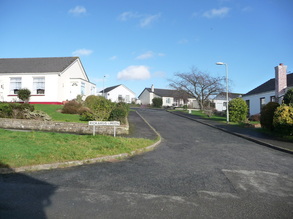Landscape & History
|
The whole area of Abbotsham Parish is underlain by shaley culm measures which have been dissected by small streams to form a landscape of small hills (highest point 110m) and valleys. Where the land meets the sea at Abbotsham Cliffs and Green Cliff there are narrow pebbly beaches and a wide wave cut rock shelf stretching out under the sea. Over half of the parish lies within the North Devon Coast Area of Outstanding Natural Beauty.
Most of the land is given over to farming, characterised by relatively small fields bounded by banks and hedgerows. Although trees are abundant there are very few large areas of woodland. As a result there are beautiful open views over much of the parish and out to sea. Most of the land is under pasture, mainly for sheep grazing, but in recent years there has been an increase in maize growing for winter fodder. The soils on the slopes are generally shallow and the rock very near the surface. In the past the stone was quarried for local building throughout the parish. In addition a narrow seam of lenticular anthracite, outcropping near Green Cliff, was utilised in the lime kiln on the cliffs to burn limestone brought across from Wales for agricultural use. |
|
The village has a long history. A report on the village by the Devon Archaeological Society reveals that the area was populated in Neolithic times. Field walking identified flint tools throughout the village with the greatest concentration on the Cornborough ridge. Settlement continued through the centuries and in 974 there is a record of the village, then known as Hame (from Old English for enclosure) being given to Tavistock Abbey by Aelfwynn the wife of Ordulf the King of England’s brother in law. The village is still referred to as Hame in the Doomsday Book was already well populated and highly rated. The name soon became Abbotsham, the hamlet belonging to the Abbot. This continued until the dissolution of the monasteries in 1539. In 1193 the church, which was then on a ridge overlooking the sea, was also given to the Abbot. In the thirteenth century a new church was built a mile inland and became the nucleus of the present village.
|
|
The village remained a typical, self-contained, Devon farming community until the middle of the 1800’s when a number of new stone dwellings were built in the centre of the village and many of the farmhouses enlarged to make gentlemen’s houses. A school was built next to the Church and a Baptist Chapel built on the Greencliff road. There was a slow development over the next hundred years with houses being built for local families whilst the village still remained attractive as retirement location to gentlemen from ‘away’. There was still a real air of self sufficiency. Local quarries, which are found throughout the village, supplied building stone. A sizeable quarry opposite Chaltaborough, in the hamlet known as Pitt, continued operating under the early years of twentieth century. Lime kilns at Greencliff and Abbotsham Cliff provided lime for the local farms. An examination of census records showed the presence of blacksmiths, carpenters, masons, wheelwrights, dressmakers, shoemakers and all the farm and estate trades.
|
|
The next burst of building occurred in the late 1960s and early 1970s when the new road, by passing the centre of the village by the pub, was completed and new houses were built on Old Road, Shepherd’s Meadow and Rickards Green. The majority of these properties were inhabited by people working in the area as the economy of North Devon grew with major investments such as Appledore Shipbuilders, AMP and Anglo Vulcanising. There was then a lull in development as the local sewage system had reached capacity. Following improvements by South West Water in the 1990s further building has taken place in the last decade to give us the village we have today. One recent development has been the growth of the Kenwith Castle retirement community which straddles the Abbotsham Bideford boundary.
|
The population of the parish was 361 in the census of 1851 and 451 in 1900 but this was for a larger area than the existing Civil Parish. The first half of the twentieth century saw the population decline, as in all agricultural areas. In the second half of the twentieth century the number of dwellings grew fairly quickly due to several new housing developments so that by 2001 the population numbered 434, growing to 489 by 2011. A large proportion of the present population are retired people who enjoy living in a quiet community within easy reach of the town of Bideford. People of working age make up 50% of the population and there are 62 children. After many years of decline the number of children has been reversed as more young families are able to move into the village. (February 2014)





